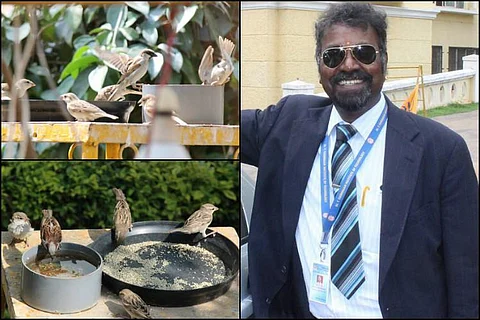

For many of us city dwellers, waking up to the sound of chirping sparrows is little more than a childhood memory now. And for many others, it will merely be something that they read about in books or experience on vacations to greener locales.
The house sparrow used to be a common visitor to the Indian household. N Subramoney, a resident of Kolar Gold Fields (KGF) colony in Kolar, Karnataka, remembers vividly how his mother would feed sparrows when he was a child. “It makes me sad that our grandchildren won’t be seeing too much of these clever little creatures in the future,” the 64-year-old says.
Subramoney is a soft skills trainer at Dr T Thimmaiah Institute of Technology and says that after teaching, environment and conservation are his second passion. Perhaps that is why he has made a sanctuary of sorts within his three decade old home for over a hundred sparrows.
Subramoney and his wife have a 35x80 feet space dedicated to a garden outside their home at KGF colony. A look at this space gives an idea of the time, effort, and energy that Subramoney has put into making his home friendly for the little birds.
.jpg?w=640&auto=format%2Ccompress)
.jpg?w=640&auto=format%2Ccompress)
There’s plenty of green (300 species of plants, Subramoney says), but there are also bird baths and bowls. However, what’s most striking is the little birdhouses – you’ll find conventional ones shaped like a hut and made out of unpainted plywood but you’ll also find others made out of old pipes, bottles, bamboo and cardboard.
“They’re clever little engineers, sparrows. Once they find their way here, they’ll make homes out of the bare basics,” says Subramoney, referring to the sparrows’ ability to use different materials to make nests.

It all started five years ago when Subramoney set up the first of the bird baths when he noticed a few sparrows visiting his garden.
“It didn’t happen immediately. It took a few weeks and months but once the sparrows understood that they weren’t in danger here, they started coming here regularly… even nesting,” he narrates.
Subramoney’s routine now begins at 4.30am every day when the sparrows start coming into the garden. “They’re my alarm. They chirp almost as if to welcome me, because they know I’m coming,” he says.
He buys about 30kg of millets only to feed the birds. But apart from feeding and setting up birdhouses, Subramoney also has to ensure that they are safe from predators like monkeys and cats.
Over time, he has learnt to place the birdbaths and grain bowls in places that are high enough so that the cats can’t get there and in places that won’t be easily accessible to monkeys.
The whole thing sounds like considerable work for an elderly couple. But for Subramoney, the joy of seeing the birds, a symbol of his own childhood, trumps all else. “It’s not a bother at all. In fact, I really miss my sparrows when I am not at home,” he says.
Subramoney has also promoted conservation in his friends' circle as well as the institute he teaches.
He and his friends at the KGF colony meet every weekend and talk about things that make them happy. They call it the “Happy Academy”. The topic of sparrows inevitably comes up and since many other residents at the colony showed interest, Subramoney started building and giving them a few birdhouses to keep in their gardens as well.
So far, he says as many as 25 families have taken to keeping birdhouses in their gardens to invite birds, and not just sparrows: “One household even has lots of parrots coming!” Subramoney says.


Noting his passion for conservation, Dr T Thimmaiah Institute of Technology granted him access to 10 acres of land where Subramoney says, he has helped plant 1500 trees and has spotted at least 65 species of birds.
But are such conservation efforts possible in a city like Bengaluru, which is teeming with concrete structures and threatened by a diminishing green cover?
“Absolutely,” says Subramoney. “If you look at old houses and bungalows, they had small holes in a wall. They were meant for birds to nest. We haven’t always been far away from nature, and if you have the will, it is possible to provide refuge to at least two sparrows in your own balcony. All you need is some greens, a water bowl and a birdhouse."
(All photos courtesy N Subramoney)